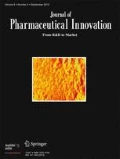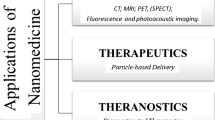Abstract
Purpose
Nanoparticle drug delivery systems are typically designed such that the drug is uniformly dispersed in their structure. Considering this point, clearly much amount of drug is inevitably present in outer layers. Hence, any unpredictable degradation leads to premature drug release with subsequent off-target toxicity. To overcome these issues, a new model of nanoparticles with a non-uniform drug concentration pattern is proposed.
Methods
In this new model, much amount of drug is located in the central parts of the sphere and decreases to eventually reach zero at the outermost layer. A numerical simulation is performed to model this system. Four different non-uniform patterns, including linear, 2nd order (type 1 and 2), and cosine, have been examined through this study.
Results
Results reveal that the general behavior of nanoparticles is affected by the way the drug is distributed in its structure. In non-uniform cases, nanoparticle degradation and subsequent drug release rate are significantly slower than the uniform state, for instance, after passing 11 h, about 90% of nanoparticle with uniform pattern has been degraded, while only an average of 18% was lost from non-uniform cases during this period; thus these new nanoparticles offer more stability for long-term circulation. In non-uniform approach, as opposed to uniform, no initial burst release is observed, and drug release profile follows almost a linear pattern. Furthermore, results show an average increase of 45% in final drug concentration after non-uniform nanoparticles’ fully degradation compared to uniform one.
Conclusion
Based on these findings, by the development of such designs, more efficient drug delivery will be somehow guaranteed.








Similar content being viewed by others
Data Availability
The datasets generated during and/or analyzed during the current study are available from the corresponding author on reasonable request.
References
Michalowski C, Guterres S, Dalla CT. Microdialysis for evaluating the entrapment and release of a lipophilic drug from nanoparticles, Journal of pharmaceutical and biomedical analysis. J Pharm Biomed Anal. 2004;35:1093–100. https://doi.org/10.1016/j.jpba.2004.04.002.
Mobaraki M, Soltani M, Zare Harofte S, Zoudani EL, Daliri R, Aghamirsalim M, Raahemifar K. Biodegradable nanoparticle for Cornea drug delivery: focus review. Pharmaceutics. 2020;12:1232. https://doi.org/10.3390/pharmaceutics12121232.
Madheswaran T, Baskaran R, Yoo BK, Kesharwani P. In vitro and in vivo skin distribution of 5α-reductase inhibitors loaded into liquid crystalline nanoparticles. J Pharm Sci. 2017;106:3385–94. https://doi.org/10.1016/j.xphs.2017.06.016.
Shah A, Aftab S, Nisar J, Ashiq MN, Iftikhar FJ. Nanocarriers for targeted drug delivery. J Drug Deliv Sci Technol. 2021;102426. https://doi.org/10.1016/j.jddst.2021.102426.
Blanco E, Shen H, Ferrari M. Principles of nanoparticle design for overcoming biological barriers to drug delivery. Nat Biotechnol. 2015;33:941. https://doi.org/10.1038/nbt.3330.
Leite DM, Sousa DM, Lamghari M, Pêgo AP. Exploring poly (ethylene glycol)-poly (trimethylene carbonate) nanoparticles as carriers of hydrophobic drugs to modulate osteoblastic activity. J Pharm Sci. 2020;109:1594–604. https://doi.org/10.1016/j.xphs.2020.01.007.
Rahman M, Beg S, Alharbi KS, Alruwaili NK, Alotaibi NH, Alzarea AI, Almalki WH, Alenezi SK, Altowayan WM, Alshammari MS. Implications of solid lipid nanoparticles of ganoderic acid for the treatment and management of hepatocellular carcinoma. J Pharm Innov. 2021;16:359–70. https://doi.org/10.1007/s12247-020-09450-4.
Davoodi P, Lee LY, Xu Q, Sunil V, Sun Y, Soh S, Wang CH. Drug delivery systems for programmed and on-demand release. Adv Drug Deliv Rev. 2018;132:104–38. https://doi.org/10.1016/j.addr.2018.07.002.
Yun YH, Lee BK, Park K. Controlled drug delivery: historical perspective for the next generation. J Control Release. 2015;219:2–7. https://doi.org/10.1016/j.jconrel.2015.10.005.
Das M, Duan W, Sahoo SK. Multifunctional nanoparticle–EpCAM aptamer bioconjugates: a paradigm for targeted drug delivery and imaging in cancer therapy, Nanomed: Nanotechnol. Biol Med. 2015;11:379–89. https://doi.org/10.1016/j.nano.2014.09.002.
Wang B, Zhang K, Wang J, Zhao R, Zhang Q, Kong X. Poly (amidoamine)-modified mesoporous silica nanoparticles as a mucoadhesive drug delivery system for potential bladder cancer therapy. Colloids Surf B. 2020;189: 110832. https://doi.org/10.1016/j.colsurfb.2020.110832.
Kadari A, Pooja D, Gora RH, Gudem S, Kolapalli VRM, Kulhari H, Sistla R. Design of multifunctional peptide collaborated and docetaxel loaded lipid nanoparticles for antiglioma therapy. Eur J Pharm Biopharm. 2018;132:168–79. https://doi.org/10.1016/j.ejpb.2018.09.012.
Soheili S, Mandegar E, Moradikhah F, Doosti-Telgerd M, Javar HA. Experimental and numerical studies on microfluidic preparation and engineering of chitosan nanoparticles. J Drug Deliv Sci Technol. 2021;61: 102268. https://doi.org/10.1016/j.jddst.2020.102268.
Liu Y, Shah S, Tan J. Computational modeling of nanoparticle targeted drug delivery. Rev Nanosci Nanotechnol. 2012;1:66–83. https://doi.org/10.1166/RNN.2012.1014.
Shamsi M, Mohammadi A, Manshadi MK, Sanati-Nezhad A. Mathematical and computational modeling of nano-engineered drug delivery systems. J Control Release. 2019;307:150–65. https://doi.org/10.1016/j.jconrel.2019.06.014.
Sahai N, Gogoi M, Ahmad N. Mathematical modeling and simulations for developing nanoparticle-based cancer drug delivery systems: a review. Curr Pathobiol Rep. 2021;1–8. https://doi.org/10.1007/s40139-020-00219-5.
Chen Z, Zhao P, Luo Z, Zheng M, Tian H, Gong P, Gao G, Pan H, Liu L, Ma A. Cancer cell membrane–biomimetic nanoparticles for homologous-targeting dual-modal imaging and photothermal therapy. ACS Nano. 2016;10:10049–57. https://doi.org/10.1021/acsnano.6b04695.
Lee SJ, Min HS, Ku SH, Son S, Kwon IC, Kim SH, Kim K. Tumor-targeting glycol chitosan nanoparticles as a platform delivery carrier in cancer diagnosis and therapy. Nanomedicine. 2014;9:1697–713. https://doi.org/10.2217/nnm.14.99.
Khaledian M, Nourbakhsh MS, Saber R, Hashemzadeh H, Darvishi MH. Preparation and evaluation of doxorubicin-loaded PLA–PEG–FA copolymer containing superparamagnetic iron oxide nanoparticles (SPIONs) for Cancer treatment: combination therapy with hyperthermia and chemotherapy. Int J Nanomedicine. 2020;15:6167. https://doi.org/10.2147/ijn.s261638.
Dogra P, Butner JD, Ramírez JR, Chuang Y-L, Noureddine A, Brinker CJ, Cristini V, Wang Z. A mathematical model for nanomedicine pharmacokinetics and tumor delivery. Comput Struct Biotechnol J. 2020. https://doi.org/10.1016/j.csbj.2020.02.014.
Xu Y, Jia Y, Wang Z, Wang Z. Mathematical modeling and finite element simulation of slow release of drugs using hydrogels as carriers with various drug concentration distributions. J Pharm Sci. 2013;102:1532–43. https://doi.org/10.1002/jps.23497.
Harrison PJ, Wieslander H, Sabirsh A, Karlsson J, Malmsjö V, Hellander A, Wählby C, Spjuth O. Deep-learning models for lipid nanoparticle-based drug delivery. Nanomedicine. 2021;16:1097–110. https://doi.org/10.2217/nnm-2020-0461.
Khorram A, Vahidi B, Ahmadian B. Computational analysis of adhesion between a cancer cell and a white blood cell in a bifurcated microvessel. Comput Methods Programs Biomed. 2020;186: 105195. https://doi.org/10.1016/j.cmpb.2019.105195.
Eltayeb M, Yahya I. Computational approaches for investigating different shapes of nanoparticles-based drug delivery. bioRxiv. 2020. http://dx.doi.org/10.1101/2020.07.02.184242.
Chithrani BD, Ghazani AA, Chan WC. Determining the size and shape dependence of gold nanoparticle uptake into mammalian cells. Nano Lett. 2006;6:662–8. https://doi.org/10.1021/nl052396o.
Lee H, Fonge H, Hoang B, Reilly RM, Allen C. The effects of particle size and molecular targeting on the intratumoral and subcellular distribution of polymeric nanoparticles. Mol Pharm. 2010;7:1195–208. https://doi.org/10.1021/mp100038h.
El-Enin HAA. Development of nanostructured liquid crystalline formulation of anti-cancer drug as a new drug delivery system. J Pharm Innov. 2020;15:80–93. https://doi.org/10.1007/s12247-019-09371-x.
Muhamad N, Plengsuriyakarn T, Na-Bangchang K. Application of active targeting nanoparticle delivery system for chemotherapeutic drugs and traditional/herbal medicines in cancer therapy: a systematic review. Int J Nanomedicine. 2018;13:3921. https://doi.org/10.2147/ijn.s165210.
Zhao Y, Huan M-L, Liu M, Cheng Y, Sun Y, Cui H, Liu D-Z, Mei Q-B, Zhou S-Y. Doxorubicin and resveratrol co-delivery nanoparticle to overcome doxorubicin resistance. Sci Rep. 2016;6:1–15. https://doi.org/10.1038/srep35267.
Petschauer JS, Madden AJ, Kirschbrown WP, Song G, Zamboni WC. The effects of nanoparticle drug loading on the pharmacokinetics of anticancer agents. Nanomedicine. 2015;10:447–63. https://doi.org/10.2217/nnm.14.179.
Gonda A, Zhao N, Shah JV, Calvelli HR, Kantamneni H, Francis NL, Ganapathy V. Engineering tumor-targeting nanoparticles as vehicles for precision nanomedicine. Med One. 2019;4. https://doi.org/10.20900/mo.20190021.
Siggers JH, Leungchavaphongse K, Ho CH, Repetto R. Mathematical model of blood and interstitial flow and lymph production in the liver. Biomech Model Mechanobiol. 2014;13:363–78. https://doi.org/10.1007/s10237-013-0516-x.
Zoudani E, Soltani M. A new computational method of modeling and evaluation of dissolving microneedle for drug delivery applications: extension to theoretical modeling of a novel design of microneedle (array in array) for efficient drug delivery. Eur J Pharm Sci. 2020;105339. https://doi.org/10.1016/j.ejps.2020.105339.
Annesini MC, Marrelli L, Piemonte V, Turchetti L. Artificial organ engineering, 1st ed. Berlin/Heidelberg, Germany: Springer; 2017. https://doi.org/10.1007/978-1-4471-6443-2.
Lu J, Peters EA, Kuipers JA. Direct numerical simulation of fluid flow and mass transfer in particle clusters. Ind Eng Chem Res. 2018;57:4664–79. https://doi.org/10.1021/acs.iecr.8b00268.
Pieper S, Onafuye H, Mulac D, Cinatl J Jr, Wass MN, Michaelis M, Langer K. Incorporation of doxorubicin in different polymer nanoparticles and their anticancer activity. Beilstein J Nanotechnol. 2019;10:2062–72. https://doi.org/10.3762/bjnano.10.201.
Rajan A, Sahu NK. Review on magnetic nanoparticle-mediated hyperthermia for cancer therapy. J Nanopart Res. 2020;22:1–25. https://doi.org/10.1007/s11051-020-05045-9.
Chen S, Han Y, Huang J, Dai L, Du J, McClements DJ, Mao L, Liu J, Gao Y. Fabrication and characterization of layer-by-layer composite nanoparticles based on zein and hyaluronic acid for codelivery of curcumin and quercetagetin. ACS Appl Mater interfaces. 2019;11:16922–33. https://doi.org/10.1021/acsami.9b02529.
Kudaibergenov S, Tatykhanova G, Bakranov N, Tursunova R. Layer-by-layer thin films and coatings containing metal nanoparticles in catalysis, thin films processes-artifacts on surface phenomena and technological facets. In: Thirumalai J, editor. 2017. p. 147–164. https://doi.org/10.5772/67215.
Lengert EV, Koltsov SI, Li J, Ermakov AV, Parakhonskiy BV, Skorb EV, Skirtach AG. Nanoparticles in polyelectrolyte multilayer Layer-by-Layer (LbL) films and capsules—key enabling components of hybrid coatings. Coatings. 2020;10:1131. https://doi.org/10.3390/coatings10111131.
Author information
Authors and Affiliations
Contributions
Conceptualization: Elham Lori Zoudani, M. Soltani; Methodology: Elham Lori Zoudani, M. Soltani, Kaamran Raahemifar; Software: Elham Lori Zoudani, Validation: Elham Lori Zoudani, M. Soltani; Formal Analysis: Elham Lori Zoudani, M. Soltani; Investigation: Elham Lori Zoudani, M. Soltani; Data curation: Elham Lori Zoudani; Writing-original draft: Elham Lori Zoudani; Writing-review and editing: Elham Lori Zoudani, M. Soltani, Kaamran Raahemifar; Visualization: Elham Lori Zoudani; Supervision: M. Soltani; Project administration: M. Soltani; Resources: Kaamran Raahemifar; Funding acquisition: Kaamran Raahemifar.
Corresponding author
Ethics declarations
Competing Interests
The authors declare no competing interests.
Additional information
Publisher's Note
Springer Nature remains neutral with regard to jurisdictional claims in published maps and institutional affiliations.
Rights and permissions
About this article
Cite this article
Zoudani, E.L., Soltani, M. & Raahemifar, K. Modeling and Analysis of Nanoparticle with Non-Uniform Drug Concentration Distribution: How to Approach a Programmed Delivery?. J Pharm Innov 18, 79–89 (2023). https://doi.org/10.1007/s12247-022-09623-3
Accepted:
Published:
Issue Date:
DOI: https://doi.org/10.1007/s12247-022-09623-3




